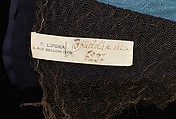Textile
Designer Sarah Lipska Polish
Not on view
This object is from a collection of sample embroideries, which was originally owned by Morris de Camp Crawford, editor of Women's Wear Daily, who collected objects which told the story of fashion and fabric history. Included in this collection was a group of textiles which illustrated what American and French designers and manufacturers were using. According to Crawford's book The Ways of Fashion, the work of Polish artist Sarah Lipska (1882-1973) was represented in this collection. Lipska is an enigmatic figure, who is known to have worked with Leon Bakst as a set and costume designer for the Ballets Russes, and later in the 1920s as a fashion designer in Paris at 4 rue Belloni, and finally as a sculptor. Extant examples of her work are rare. Although only a few pieces in the Brooklyn Museum collection bear a label or a signature, others bear hallmarks of her work, such as a distinctive form of whip stitching on appliqué work, unusual abstract motifs, and Cubist-inspired patterns.
An extraordinary object of art representing 1920s Paris, this sample is the only piece in the extensive Crawford textile collection that bears a label with Lipska's name, atelier address, and the name of the piece, "Bouddha bleu," clearly documenting its provenance. The exact source of inspiration is unknown, but based on her previous career and location in Paris, the imagery could have been inspired by various sources. Specifically, it could be inspired by her time working with Bakst at the Ballets Russes, which produced an Orientalism-influenced ballet titled "Le Dieu Bleu" in 1912. Bakst designed the costumes, Jean Cocteau wrote the story and Vaslav Nijinsky performed the part of the Blue God, who magically destroyed fantastical creatures for the sake of true love. Although the ballet was performed more than ten years before the production of this design, it is certain that Lipska worked with Bakst and this piece could be Lipska's creative expression inspired from that particular ballet. However, it also references the dancer Josephine Baker, particularly the central figure made of blue rhinestones wearing a costume strikingly similar to the costume worn by Baker while performing the Danse Banane in the Folies Bergère production of Un Vent de Folie in 1927.
Lipska is a little known artist but this particular piece, a rare confirmation of her atelier's existence, inspires further research on this interesting woman and firmly documents her penchant for whip stitched appliqué work and unusual motifs. Whatever the inspiration may be, the work is enchanting and proves the place of Lipska as a designer in her own right.
This image cannot be enlarged, viewed at full screen, or downloaded.
This artwork is meant to be viewed from right to left. Scroll left to view more.




